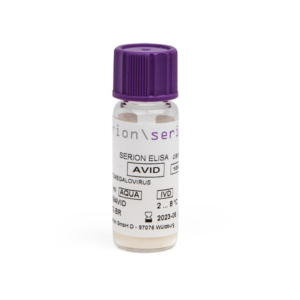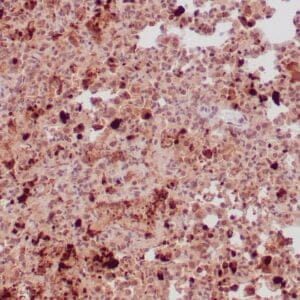| Weight | 1 lbs |
|---|---|
| Dimensions | 9 × 5 × 2 in |
| target | Toxoplasma gondii |
| species reactivity | Toxoplasma gondii |
| applications | ELISA |
| assay type | Indirect & quantitative |
| available size | lyophilized |
Toxoplasma gondii Avidity Reagent B110AVID
$75.00
Summary
- Virion/Serion Immunologics avidity reagent for research use (RUO)
- Toxoplasma gondii Avidity Reagent, recombinant
- Applications: ELISA
- For use with SERION ELISA classic assays
- Reconstitute to 2 mL (13 samples)
Toxoplasma gondii Avidity Reagent B110AVID
| kit |
|---|
| Research area Infectious Disease |
| Storage Store at 2 - 8°C until expiration on packaging. |
| Form ready |
| Associated products Toxoplasma gondii Avidity Reagent (B110AVID) Toxoplasma gondii Antigen (BA110VS) Toxoplasma gondii IgG Control Serum (BC110G) Toxoplasma gondii IgM Control Serum (BC110M) Toxoplasma gondii IgG ELISA Kit (ESR110G) Toxoplasma gondii IgM ELISA Kit (ESR110M) |
| target relevance |
|---|
| Organism Toxoplasma gondii |
| Protein names Toxoplasma gondii |
| Structure and strains Toxoplasma gondii is a parasitic protozoan (specifically an apicomplexan) that causes toxoplasmosis. Found worldwide, T. gondii is capable of infecting virtually all warm-blooded animals,: 1 but felids are the only known definitive hosts in which the parasite may undergo sexual reproduction. |
| Detection and diagnosis The diagnosis of toxoplasmosis is based on clinical findings and serological investigations. ELISA tests are recommended for the demonstration of IgG and IgM antibodies. Screening for Toxoplasma infections during pregnancy is of significant importance in prenatal care. The transmission of Toxoplasma gondii via the transplacental route has been observed in all stages of pregnancy, although the risk of a prenatal transmission as well as the outcome of infection depends on the stage of pregnancy. The risk of an infection of the unborn child via transplacental transmission is limited to seronegative women who acquire a primary infection during pregnancy. IgM antibodies directed against Toxoplasma gondii can persist for months after infection. Therefore, the determination of the IgG antibody avidity allows for differentiation of primary from past infections. |
Data
Publications
| pmid | title | authors | citation |
|---|---|---|---|
| We haven't added any publications to our database yet. | |||
Protocols
| relevant to this product |
|---|
| ESR110G protocol |
Documents
| # | ||
|---|---|---|
| ECP0065 | Safety Data Sheet | QC certificate |
Only logged in customers who have purchased this product may leave a review.









Reviews
There are no reviews yet.